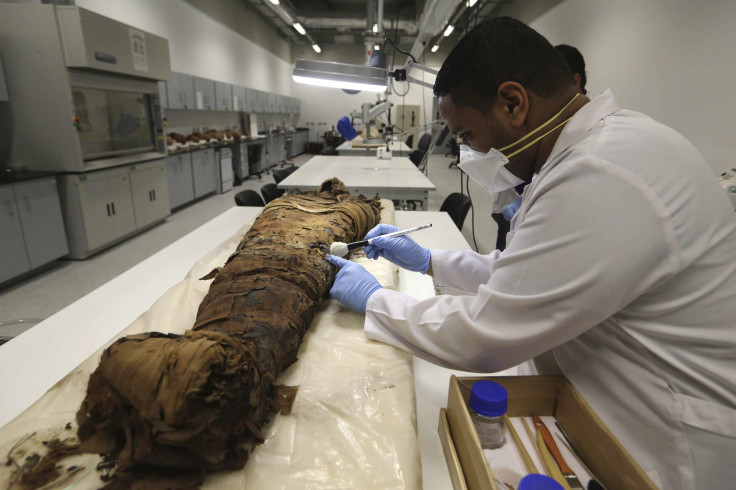More Than 13 Intact Coffins Dating Back 2,500 Years Discovered In Egypt

KEY POINTS
- The coffins were unearthed from a burial well in the desert necropolis of Saqqara
- Egypt’s Ministry of Tourism and Antiquities announced the findings on social media
- The coffins were so well preserved that some had their external colorations still intact
Egyptian authorities have discovered a trove of more than 13 intact wooden human coffins dating back 2,500 years in a burial well in the desert necropolis of Saqqara.
Egypt’s Ministry of Tourism and Antiquities announced the findings on Facebook on Sept. 6, adding that most of the coffins appeared to be sitting undisturbed over the millennia.
According to the Ministry, the sarcophagi were found in a burial shaft about 36 feet below the ground, stacked on top of each other, so well preserved that some of the colors painted on the wood are still visible. The coffins were initially analyzed and determined to have been sealed as early as they were buried.
Three sealed niches were also found inside the burial ground, with the archeologists expecting to unearth more coffins therein, Khaled Al-Anani, Egypt’s Tourism and Antiquities Minister, told Science Alert.
The excavation work at the site is still underway.
"An indescribable feeling when you witness a new archaeological discovery," Al-Anani wrote on Twitter, thanking his colleagues. "Stay tuned for the announcement of a new discovery in Saqqara he added," posting a promotional video signaling future revelations from the site.
شعور لا يقارن كلما تشهد كشف اثري جديد،
— Khaled El-Enany (@KhaledElEnany6) September 6, 2020
انتظروا الاعلان عن كشف اثري جديد بسقارة، شكرا لزملائي بالوزارة.
An indescribable feeling when you witness a new archeological discovery.
Stay tuned for the announcement of a new discovery in Saqqara
Thank you to my colleagues in the ministry pic.twitter.com/RpgK6TmREo
The Ministry reportedly is set to release a series of promotional films with new details about the burial site.
The vast burial complex in Saqqara, believed to have been the ancient capital of Memphis, is located 19 miles south of Cairo. Experts believe that Saqqara had been an active burial site for the Egyptians for 3,000 years, where both people belonging to high social standing or lower classes were interred.
The tombs of the high-ranking nobility and officials, easier to find, given the elaborate manner they were buried, have been previously found to preserve grave goods such as their cartouches and even mummified animal remains. According to Science Alert, the recent excavations appeared to be simpler burials, apparently of people from middle or working classes.
Many of the richly interred tombs have been looted in the past decades and with the new discovery of the completely intact and unopened coffins, archeologists hope to find untouched grave goods inside, which experts believe would potentially help identify the remains and their social standing.
© Copyright IBTimes 2025. All rights reserved.






















